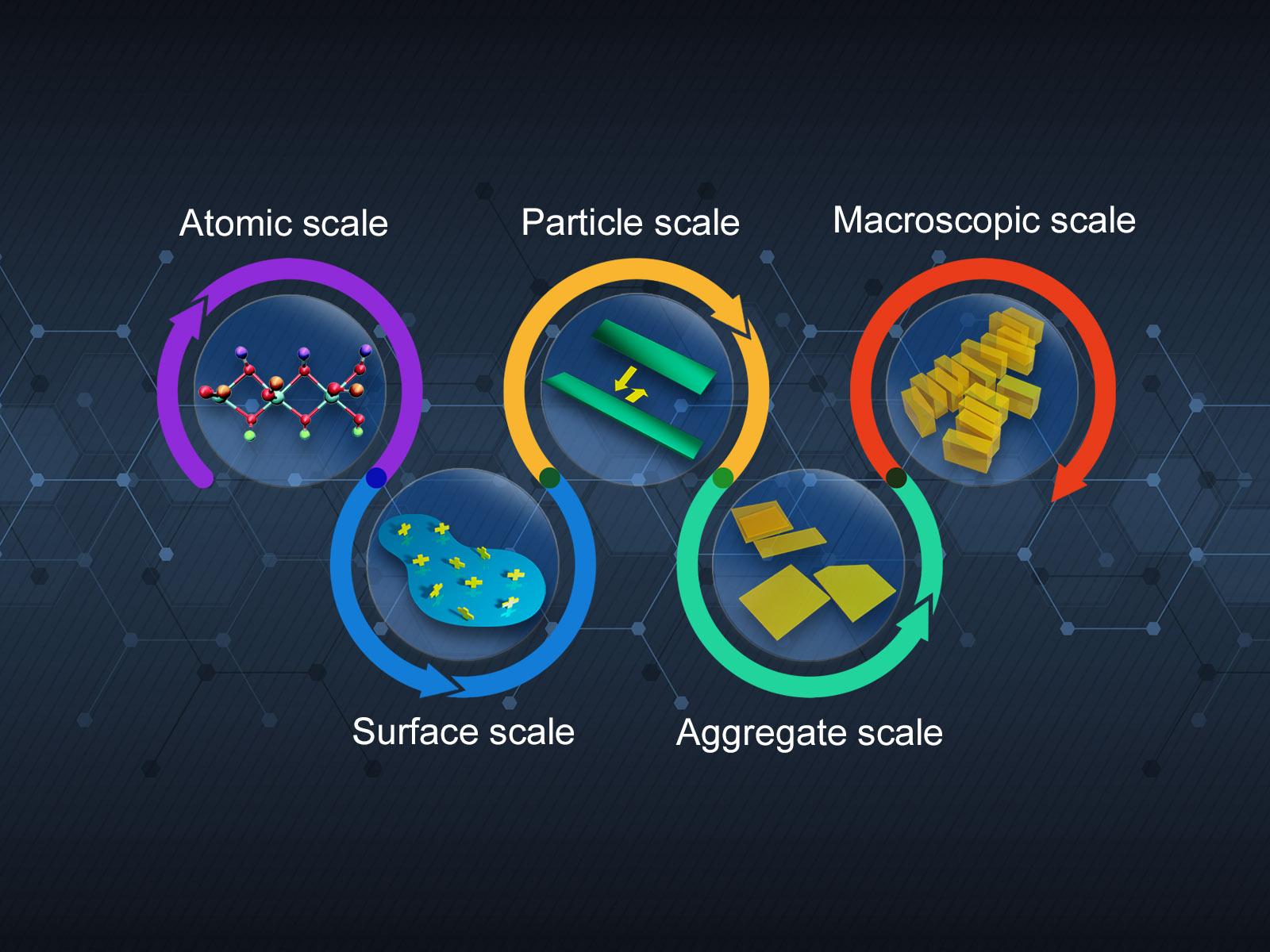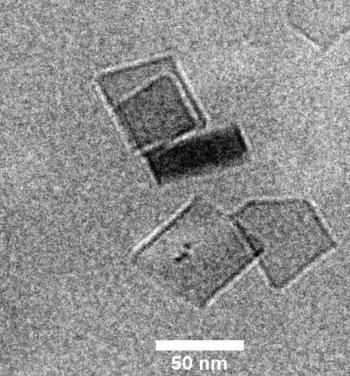Predicting Nanoparticle Assembly Across Scales
Bringing together expertise allows researchers to predict nanoparticle attachment from the atomic to microscopic scale

Bringing together expertise across scales enabled researchers to develop a rich picture of how nanoplatelets aggregate and assemble.
(Illustration by Mike Perkins | Pacific Northwest National Laboratory, courtesy of ACS Nano)
What do legacy tank waste, large-scale mining operations, and some sunscreens have in common? They all either produce or contain nanoparticles. In solution, such as in legacy tank waste, nanoparticles move, collide, and interact. This leads to the formation of larger, more complex structures known as assemblies or aggregates.
Because nanoparticles behave in complicated ways, the final nature of the aggregates and assemblies has been extremely challenging to predict—until now. Research from the Interfacial Dynamics in Radioactive Environments and Materials (IDREAM) Energy Frontier Research Center (EFRC) has developed a comprehensive and predictive picture of boehmite nanomaterials.
The work, published in ACS Nano and led by Pacific Northwest National Laboratory (PNNL) Materials Scientist Elias Nakouzi, created connections across scales and orders of magnitude different in size. It starts at the atomic level and ends with measuring the structure of aggregates several micrometers in size.
“We took an approach that is really only possible through a project like an EFRC,” said Nakouzi. “This work brought together so many people who are experts in different fields. We were able to use best in class tools at each different scale to really understand what was happening to the boehmite.”
A model system for modeling systems
The team, which includes researchers from multiple national laboratories and universities, focused their efforts on the aggregation of boehmite. Boehmite, a type of aluminum-based mineral, is found in industrial waste and in the legacy tank waste at the Hanford site. Researchers across IDREAM have spent time developing an understanding of boehmite and its behavior under a wide range of conditions.
“During waste remediation efforts, understanding how the solution behaves is essential for effective and safe work,” said Jacob Reynolds of Washington River Protection Solutions. As large aggregates have different properties than individual particles, identifying what type of aggregates are in solution can help create an accurate picture of the overall solution, especially since the ability to pump and treat the waste depends on the solution properties.
Previous work trying to predict nanoparticle assembly focused primarily on ball-shaped nanoparticles. While these are more straightforward to model, they don’t represent most nanoparticles in the real world. Boehmite commonly forms nanoplatelets, which have multiple types of surfaces with different properties. If the particles attach via different surfaces, the final aggregates can have a wide range of shapes and behavior. This makes predicting how the boehmite will aggregate extra challenging.
The combination of a difficult problem with established expertise made boehmite a very useful model system. “One of the things I’m most excited about with this study is how general the approach can be,” said Nakouzi. “While we focused on boehmite because it’s an important material we’ve spent years studying, the individual steps can be applied to other materials and systems.”
Creating a picture from atoms to aggregates

Creating a multiscale understanding requires combining experimental data with simulations of scales too small to see. The team used computer simulations to explore how atoms on the nanoplatelet surfaces interact with other parts of the solution. They showed that the different surfaces do not behave the same at a molecular level. The team then took this information to create a slightly larger model that represents the entirety of the different surfaces, calculating how the surfaces interact with each other.
The surface models allowed the researchers to predict how the nanoplatelets would aggregate. A weakness of previous approaches has been an inability to represent particles with different surfaces, such as nanoplatelets. The detailed surface models allowed the team to create testable aggregation models.
At this point, the work shifted from theoretical models on a screen to real particles inside a microscope. PNNL Materials Scientist Lili Liu used a transmission electron microscope to watch the nanoplatelets aggregate in real time. “I saw the exact structures our theory work predicted appear under the microscope,” said Liu. “It was amazing.”
The final piece of the puzzle was examining the larger aggregate structure, accomplished through neutron scattering measurements performed at the National Institute of Standards and Technology Center for Neutron Research. The team found that, as predicted by other data, the boehmite aggregates were dense with stacks of platelets. Access to this national user facility helped confirm the accuracy of the approach, showing that information from the smallest scales can point to larger scale behavior while also illuminating how the aggregate structures affect the pumping of the legacy nuclear wastes.
Taking the next steps
This study focused on boehmite nanoplatelet behavior at high pHs, the conditions commonly found in legacy tank waste. The team is thinking about exploring different solution conditions and particle shapes to arrive at a predictive capability that can be generalized for any materials system.
“Platelets have clearly defined surfaces,” said Nakouzi. “We want to push forward and see what happens when we have more complicated mixtures of particles. For example, how would spheres and platelets interact?”
As the team continues their work, they also anticipate that others will take their concept and use it on other systems. By creating detailed models of relevant nanomaterials, scientists can identify the fundamental principles that influence large-scale behavior of groups of particles. This has potential applications across industries, as aggregation can be either a goal or a potential problem.
“Taking the first step is often the biggest challenge,” said PNNL Chemical Engineer Jaehun Chun. “Since we’ve shown how well this approach works, we hope people will take the steps we describe and use them. The more we learn about different types of nanomaterials, the richer our understanding of their behavior across scales will become.”
In addition to Nakouzi, Liu, and Chun, PNNL co-authors include Ben Legg, Xin Zhang, Carolyn Pearce, Kevin Rosso, Greg Schenter, and Jim De Yoreo. Co-authors from Oak Ridge National Laboratory are Lawrence Anovitz and Andrew Stack. Co-authors from the NIST Center for Neutron Research are Markus Bleuel and David Mildner. Academic co-authors are Williams Smith of Washington State University, Reed Harper of the University of North Florida, and Aurora Clark of the University of Utah.
Published: November 21, 2023